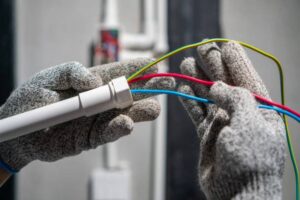May 26 Network Cable Topography: Unraveling the differences between audio cables and computer cables
In Bridge Cabling, Cable Safety, Fiber Optic Cables, Fire Alarm System, Network Cabling Installation, Network Cabling, Network Cabling Services, Surveillance Cameras, Structured Cabling, Telecommunications, Wireless Network Installation
By admin
In the complex web of network infrastructure, distinguishing between voice and computer cables is key to building efficient and reliable communications systems. As technology advances, the demand for network cables evolves, requiring a careful understanding of the unique characteristics of audio and computer cables. In this blog post, we’ll explore the key differences between audio cables and computer cables, highlighting their respective roles, specifications, and considerations in network cabling installation.
1. Purpose and function
At its core, the primary distinction between audio and computer cables lies in their intended purposes and functions. Audio cables, often referred to as telephone or communications cables, are specifically designed to carry analog or digital audio signals. It serves as the backbone for telephone systems, intercoms, and other communications devices.
Computer cables, on the other hand, are designed to facilitate data transfer between computers and networking equipment. It supports digital signaling and is an integral part of the functioning of local area networks (LAN), connecting computers, servers, switches and other network devices.
2. Types and categories of cables
Audio cables typically use twisted pair cables, commonly known as Category 3 (Cat3) or Category 5e (Cat5e) cables. These cables are suitable for transmitting audio signals over short to medium distances. Cat5e cables with enhanced performance characteristics have become the standard for audio applications due to their ability to support higher frequencies and reduce interference.
Computer cables, on the other hand, often use high-quality twisted pair cables such as Cat5e, Cat6, Cat6a, or even Cat7. These cables are designed to handle higher data transfer rates and provide better computer networking performance. The choice of cable category depends on the specific requirements of the network, including bandwidth, data transfer speed, and overall network performance.

3. Connectors and terminations
Audio cables commonly use RJ11 connectors, which have fewer pins compared to the larger RJ45 connectors used in computer cables. RJ11 connectors are standard for telephone systems and are suitable for transmitting audio signals.
Computer cables are mostly based on RJ45 connectors, which are known for their versatility and compatibility with a wide range of network devices. These connectors accommodate a larger number of pins, making them well-suited for handling the complex data signals required for computer networks.
4. Data transfer speed
Audio cables are generally designed to support low data transfer speeds suitable for voice communications. For example, Cat5e voice cables can handle data rates up to 100 Mbps, which is sufficient for voice applications.
Computer cables, especially with high-quality categories such as Cat6, Cat6a, or Cat7, are designed to support significantly higher data transfer speeds. For example, Cat6 cables can handle data rates up to 10 Gbps, making them well-suited for high-speed data applications within computer networks.


5. Network infrastructure considerations
Audio cables are commonly used for telephone systems in residential and commercial environments. It is often distributed using a star topology, where individual telephone lines connect to a central distribution point. The star architecture simplifies troubleshooting and maintenance of individual voice connections.
Computer cabling, on the other hand, is typically integrated into the broader network infrastructure, following a hierarchical or distributed architecture. Networks often use structured cabling systems, which provide a comprehensive, structured approach to cabling installations, allowing for scalability, flexibility, and easier management of network components.
6. Crosstalk and interference
Audio cables are generally considered more tolerant to interference, as voice signals are less susceptible to interference than data signals. Cat5e cables used for audio applications are designed to reduce interference within the cable, ensuring a clear and reliable voice connection.
Computer cables, especially in high-performance networks, require greater attention to interference and interference. High-quality cables with enhanced shielding and twisted pair configurations, such as Cat6 and above, are specifically designed to reduce interference and enhance the integrity of data signals, ensuring optimal network performance.
7. Future proofing and scalability
While audio cables may require upgrades or replacements to accommodate newer technologies, they are generally less affected by rapid developments than computer cables. Voice communications systems tend to have a longer life cycle, and upgrades are often driven by changes in communications technologies rather than the necessity of supporting higher data rates.
Computer cables, especially in enterprise environments, often emphasize future-proofing and scalability. High-quality cables and advanced network infrastructure components are selected to ensure compatibility with emerging technologies, support increasing data demands, and provide a strong foundation for future network expansions. Of all the network cable companies, Bridge Cable is the one to call for your audio and computer cable needs at 877-832-1206!
Understanding the differences between audio and computer cables is pivotal to designing and maintaining efficient and reliable communications systems. Audio cables, with their focus on transmitting analog or digital audio signals, serve as the backbone of telephone systems, while computer cables, designed to transmit digital data, are an integral part of computer networking functions. Knowing the specific requirements, types of cables and connectors, and considerations for each type of cable ensures optimal performance of audio and computer communications systems in a variety of settings. As technology continues to evolve, a precise understanding of these cabling nuances becomes increasingly essential to building a resilient, future-ready network infrastructure.
For assistance with any project or installation in the New Jersey or Philadelphia area, please call us at 877-832-1206.
For more ideas please visit – https://www.bridgecable.com/services/
Copyright © 2024 Bridge Cable. All rights reserved.
2066 W. Hunting Park Ave, STE 308, Philadelphia, PA 19140
Mail: 2745 Terwood Road Willow Grove, PA 19090




